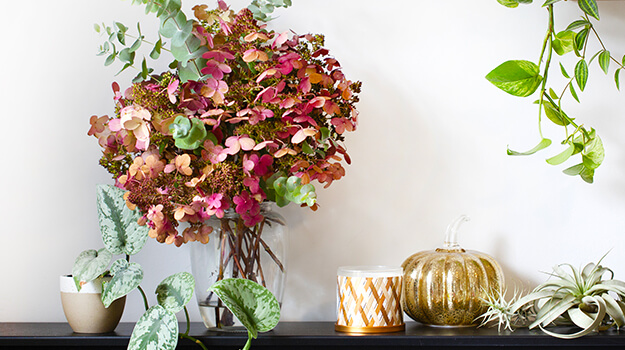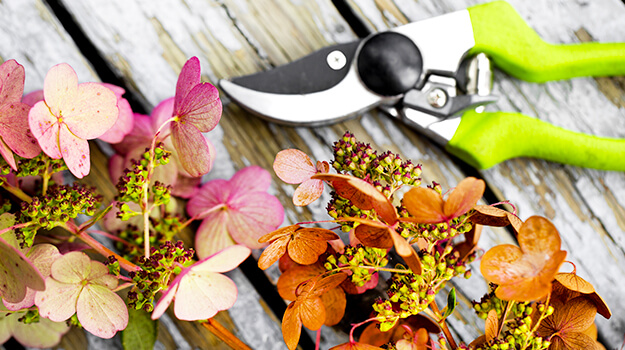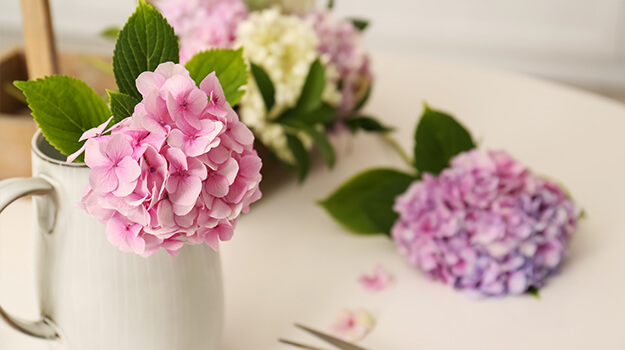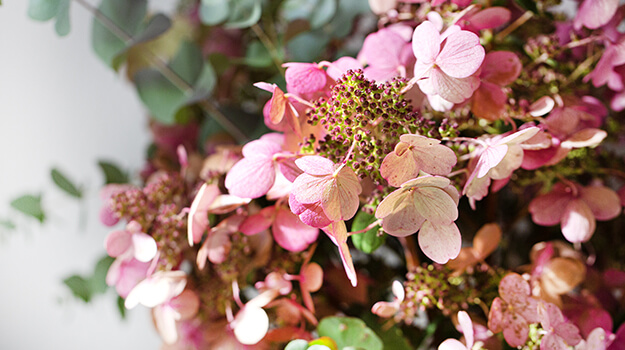Hydrangeas are among the easiest flowers to dry. As proof, at the end of the season, their dried clusters of flowers, similar to paper flowers, can spend part of the winter hanging from the branches.
When harvested at the right time and dried using one of the methods presented below, you get beautiful bouquets of dried flowers, colourful and long-lasting.
When and how to harvest hydrangeas to dry them?
Some cut flower enthusiasts criticize dried flowers for their dying and mummified appearance. However, by choosing the right varieties and using the appropriate drying method, bouquets of dried flowers can be much more than pale substitutes for bouquets of fresh flowers.
The best time to harvest hydrangea flowers is at the end of bloom, around the end of September or the beginning of October. If you pick them before the sap has had time to go back down, the sepals will wilt.
Choose a sunny and dry day to cut the hydrangea branches. Keep a stem at least 10 cm long. By taking care to cut just above beautiful buds, the future flowering will not be compromised.
Remove the damaged flowers as well as all the leaves.
Method 1
Dry the hydrangea flowers in the open air, upside down
This is the simplest and most economical method since it does not require any product or material. Simply hang the flowers upside down using a string, ribbon or our support for drying herbs.
To make the support: DIY Herb Drying Rack
Hang your flowers in a dark room to preserve their colours. Otherwise, exposed to light, they will be a little more faded. To speed up the process and prevent rotting, use a dry and ventilated place like the garage.
Method 2
Drying flowers with or without glycerin
You can also dry hydrangeas naturally (or almost) by placing them in a vase. This method is both practical and pretty. Just do as you would with a bouquet of fresh flowers but put only 2 to 3 cm of water. The water will gradually evaporate and the flowers will dry eventually.
Tie a few hydrangea stems with a string. If necessary, cut the stems so that all the ends can be in the water.
Using glycerin allows the flowers to retain a certain flexibility while drying. They will be less fragile and less crumbly. Often used in the manufacture of cosmetic products, glycerin is sold at the pharmacy or in specialty stores.
Glycerin should be mixed with an equal part of hot water, then stirred until dissolved. Once the mixture has cooled, pour 2 to 3 cm of it into the bottom of the vase.
The drying time with the vase method can vary between 10 and 30 days. In the meantime, you can still enjoy a beautiful arrangement!
Method 3
Drying flowers with silica gel
Silica gel is suitable for all flowers, even the most fragile ones that lose their properties when using other drying methods, such as roses, violets, pansies, geraniums or daisies.
While hydrangea flowers are easy to dry, using silica gel speeds up the process, virtually eliminates the risk of mold and allows them to retain the colour they had at the time of harvest.
This product helps preserve the volume, shape and colour of the flowers. While blue, orange or pink flowers generally remain faithful, other colours lose their shine with the methods presented above.
Silica gel is sold in the form of crystals or beads on the Internet or in craft supply stores. Some can be regenerated, offering a more sustainable option. These will change colour when it is time to regenerate it.
Variation: Some experts suggest mixing silica gel with an equal part of sand. Since hydrangea flowers are large, this saves money!
How to dry flowers with silica gel
- Get an airtight container large enough to hold your flowers.
- Pour a layer of silica gel on the bottom of the container, so as to cover it.
- Place the hydrangea flowers.
- Gently cover the flowers with silica gel (make sure it penetrates between the inflorescences and does not crush them).
- Close the container and wait 2 or 3 days, or until the flowers are dry.
- Use gloves to gently extract the flowers.
How to extend the life of your dried flowers
Once your flowers are completely dry, you can spray them with hairspray if you wish. This protects them from dust and humidity. Repeat the application every year. Be aware, however, that the lacquer will make them slightly yellow, which is why some people prefer not to apply it.
With or without lacquer, dried hydrangea flowers can last for years. Very pretty in a vase, they can also be used to make original floral arrangements. Watch our next articles for great ideas!
To dust them, use the hair dryer on low speed and low temperature.





